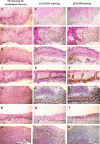p53 and Ki-67 combined with periodic acid-Schiff staining for the diagnosis of early stage esophageal squamous cell carcinoma lesions in biopsy specimens
- PMID: 39714770
- PMCID: PMC11929734
- DOI: 10.1007/s10388-024-01102-7
p53 and Ki-67 combined with periodic acid-Schiff staining for the diagnosis of early stage esophageal squamous cell carcinoma lesions in biopsy specimens
Abstract
Background: Esophageal cancer is highly prevalent in China, predominantly represented by squamous cell carcinoma. This retrospective study sought to evaluate the diagnostic efficacy of four staining protocols in identifying early stage esophageal squamous cell carcinoma (ESCC).
Methods: A consecutive series of ninety biopsy samples of esophageal mucosa, collected retrospectively from March 2016 to December 2019, were obtained at Beijing Chao-Yang Hospital, a tertiary care facility in Beijing, China. These samples were categorized into four groups: non-neoplastic squamous lesions (Non-NSL), low-grade dysplasia (LGD), high-grade dysplasia (HGD), and early stage ESCC. Baseline, molecular analyses (p53 by immunohistochemistry and Ki-67 by immunohistochemistry), and staining analyses (hematoxylin & eosin (HE) and periodic acid-Schiff (PAS) were conducted across the categories. The staining protocols included HE, HE + p53 + Ki-67, HE + p53 + Ki-67 + PAS, and HE + p53/PAS + Ki-67/PAS.
Results: Patients with HGD and ESCC were significantly older and had larger lesions. Elevated p53 and Ki-67 mutation rates were observed in HGD and ESCC, while increased PAS positivity was noted in RE and LGD. The p53, Ki-67, and PAS staining results showed mostly no correlation among the four groups. Abnormal Ki-67 basal layer distribution pattern correlated with histological grades, with higher proportions in HGD and ESCC. HE + p53 + Ki-67 + PAS and HE + p53/PAS + Ki-67/PAS demonstrated complete consistency with the reference standard, with weighted κ values of 1. HE + p53 + Ki-67 + PAS and HE + p53/PAS + Ki-67/PAS protocols exhibited 100% accuracy, sensitivity, and specificity for diagnosing ESCC or ESCC combined with HGD, outperforming the other protocols.
Conclusions: Incorporating specific staining protocols, particularly HE + p53 + Ki-67 + PAS and HE + p53/PAS + Ki-67/PAS, enhances the diagnostic accuracy for early stage ESCC, showing promise in advancing the pathology diagnostic pathway.
Keywords: Early diagnosis; Esophageal mucosa biopsy; Esophageal squamous cell carcinoma; Ki-67; P53; PAS staining; Retrospective study.
© 2024. The Author(s).
Conflict of interest statement
Declarations. Conflict of interest: The authors declare no competing interests. Ethical statement: The study was conducted in accordance with the Declaration of Helsinki and was approved by the ethics committee of Beijing Chao-Yang Hospital (No. 2023–598). Since this was a retrospective study and involved no direct patient intervention, informed consent was waived. However, all patient data were anonymized, and confidentiality was maintained throughout the study.
Figures



Similar articles
-
TGFBR3 is an independent unfavourable prognostic marker in oesophageal squamous cell cancer and is positively correlated with Ki-67.Int J Exp Pathol. 2020 Dec;101(6):223-229. doi: 10.1111/iep.12380. Epub 2020 Nov 4. Int J Exp Pathol. 2020. PMID: 33146446 Free PMC article.
-
Predicting malignant transformation of esophageal squamous cell lesions by combined biomarkers in an endoscopic screening program.World J Gastroenterol. 2016 Oct 21;22(39):8770-8778. doi: 10.3748/wjg.v22.i39.8770. World J Gastroenterol. 2016. PMID: 27818592 Free PMC article.
-
Ki-67 and ProExC are useful immunohistochemical markers in esophageal squamous intraepithelial neoplasia.Hum Pathol. 2011 Oct;42(10):1430-7. doi: 10.1016/j.humpath.2010.12.009. Epub 2011 Mar 21. Hum Pathol. 2011. PMID: 21420715
-
Mucosal iodine staining improves endoscopic visualization of squamous dysplasia and squamous cell carcinoma of the esophagus in Linxian, China.Cancer. 1998 Jul 15;83(2):220-31. Cancer. 1998. PMID: 9669803 Review.
-
Novel devices and biomarkers in screening for esophageal squamous cell cancer.Best Pract Res Clin Gastroenterol. 2025 Mar;75:102005. doi: 10.1016/j.bpg.2025.102005. Epub 2025 Mar 28. Best Pract Res Clin Gastroenterol. 2025. PMID: 40451648 Review.
Cited by
-
Human-Specific Organization of Proliferation and Stemness in Squamous Epithelia: A Comparative Study to Elucidate Differences in Stem Cell Organization.Int J Mol Sci. 2025 Mar 28;26(7):3144. doi: 10.3390/ijms26073144. Int J Mol Sci. 2025. PMID: 40243939 Free PMC article.
References
-
- Sjoquist KM, Burmeister BH, Smithers BM, Zalcberg JR, Simes RJ, Barbour A, et al. Survival after neoadjuvant chemotherapy or chemoradiotherapy for resectable oesophageal carcinoma: an updated meta-analysis. Lancet Oncol. 2011;12:681–92. - PubMed
-
- Lao-Sirieix P, Fitzgerald RC. Screening for oesophageal cancer. Nat Rev Clin Oncol. 2012;9:278–87. - PubMed
MeSH terms
Substances
LinkOut - more resources
Full Text Sources
Medical
Research Materials
Miscellaneous
